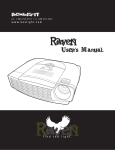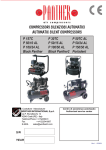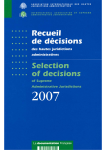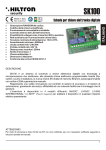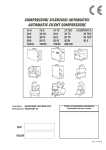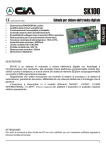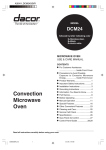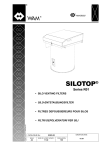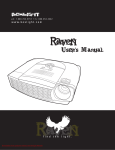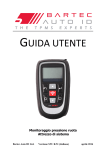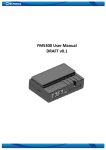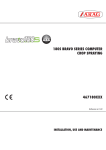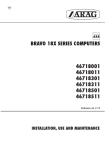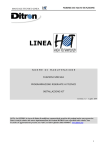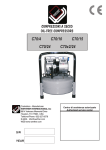Download OPERA AUTOMATIC Manuale di Istruzioni
Transcript
I Manuale Istruzione Instructions Manual OPERA AUTOMATIC TECNO-GAZ S.p.A. DENTAL AND MEDICAL EQUIPMENT Strada Cavalli N°4 , CAP 43038 -SALA BAGANZA -Parma- ITALIA TEL. +39 0521 83.80 FAX +39 0521 83.33.91 http://www.tecnogaz.com e-mail: [email protected] I Þ TECNO-GAZ TECNO-GAZ, La ringrazia di aver acquistato un prodotto della sua gamma e la invita alla lettura, in ogni parte del presente Manuale Istruzione. All’interno troverà tutte le istruzioni necessarie per un corretto utilizzo del prodotto.Si prega di seguire attentamente le avvertenze contenute, di conservarlo inalterato, facilmente reperibile ed accessibile all’operatore. Il contenuto del presente Manuale può essere modificato, senza preavviso ne ulteriori obblighi, al fine di includere variazioni e miglioramenti. È vietata la riproduzione o la traduzione di qualsiasi parte del presente manuale senza il consenso scritto di TECNO-GAZ. La informiamo che la ns. Ditta rimane a Sua completa disposizione per fornire notizie e delucidazioni in merito a tutto quanto concerne l’utilizzo del prodotto. Grazie e buon lavoro TECNO-GAZ thanks you for the purchasing a product of its range and suggests you to read in every part the present instructions manual. Inside you will find all the necessary instructions for a correct use of the product. Please follow carefully the contained attentions, to keep the manual and easily available for the operator. The content of the present instructions manual could be modified without notice and further obligations for the purpose to include improvements and upgrades. The reproduction and /or the translation of the present instruction manual is forbidden without the TECNO-GAZ written permission. We inform you, our Company will be to your complete disposal for give you every kind of information and news about the product use. Thanks and good job TECNO-GAZ S.p.A. 6 - 38 39- 72 1 DOAF051_rev2 Þ TECNO-GAZ PAR 1.1 DICHIARAZIONE CE DI CONFORMITA’ CE CONFORMITY DECLARATION La sottoscritta : The undersigned : TECNO-GAZ S.p.A. ubicata in Strada Cavalli n. 4 - CAP 43038 - Sala Baganza – Parma – ITALIA dichiara sotto la propria responsabilità che la termosigillatrice automatica a rullo: declares, under its responsability, the rotary sealing machine: Modello/ Model : OPERA AUTOMATIC Articolo/ Article : 2042-S INCOLLARE TARGHETTA costruito dalla ditta : TECNO-GAZ; È conforme alle disposizioni legislative che traspongono la Direttiva Macchine 98/37/EC, la Direttiva Bassa Tensione 2006/95/EC, la Direttiva Compatibilità Elettromagnetica 2004/108/EC e le loro successive modifiche, emendamenti ed integrazioni. is manufactured by the Company : TECNO-GAZ; in accordance to the the rules of the Directive of Machinery safety 98/37/EC, la Low Tension Directive 2006/95/EC, The EMC Directive 2004/108/EC and following modifications, amendments and adding. Nome/Name : PAOLO BERTOZZI Funzione/Position : Presidente/Chairman Sala Baganza, 15.01.2008 2 DOAF051_rev2 Þ TECNO-GAZ PAR 1.2 MARCATURA CE CE MARK PAR 1.3 ASSISTENZA TECNICA TECHNICAL ASSISTANCE TECNO-GAZ S.p.A TEL.+39 0521/ 83.80 FAX:+39 0521/ 83.33.91 www.tecnogaz.com e-mail: [email protected] 43038 - Sala Baganza Parma - Italia P.S.: L’ASSISTENZA TECNICA E’ SVOLTA DAI CONCESSIONARI TECNO-GAZ. THE TECHNICAL ASSISTANCE IS DONE BY TECNO-GAZ AGENTS. 3 DOAF051_rev2 Þ TECNO-GAZ PAR 1.4 GARANZIA 1. Il prodotto è coperto da garanzia per un periodo di 12 mesi, incluse le parti elettriche. 2. La garanzia ha inizio dalla data di consegna della macchina al cliente comprovata dalla restituzione del tagliando di garanzia allegata al Verbale d’installazione, debitamente compilati, timbrati e firmati dal rivenditore. 3. In caso di contestazione, è ritenuta valida la data indicata sulla bolla di vendita. 4. La riparazione o la sostituzione, in garanzia, di un particolare, è effettuata ad insindacabile giudizio della ditta TECNO-GAZ, e non comprende la trasferta del personale, le spese d’imballaggio e trasporto. 5. Sono escluse dalla garanzia lampade, fusibili, ed i guasti o i danni derivati da una cattiva manutenzione, negligenza, imperizia o altre cause non imputabili al costruttore. 6. I componenti soggetti a normale usura e gli accessori ( es.pulsanti, spazzole per motori elettrici, cuscinetti, rulli, cinghie ecc…)non sono compresi nella garanzia. 7. Non è riconosciuto il diritto alla sostituzione della macchina completa. 8. La garanzia non comporta alcun risarcimento danni diretti o indiretti di qualsiasi natura verso persone o cose, dovuti all’inefficienza della macchina. 9. TECNO-GAZ non risponde di guasti o danni causati dal prodotto usato impropriamente o sul quale non sia praticata la manutenzione ordinaria o siano trascurati gli elementari principi del buon mantenimento ( negligenza). 10. Non viene riconosciuto nessun risarcimento per fermo macchina. 11. La garanzia decade automaticamente qualora la macchina venga manomessa, riparata o modificata dall’acquirente o da terzi non autorizzati da TECNO-GAZ . 12. Per gli interventi, l’acquirente deve rivolgersi unicamente al rivenditore oppure ai centri di assistenza indicati da TECNO-GAZ. 13. I componenti sostituiti in garanzia devono essere restituiti a TECNO-GAZ in porto franco. 14. La mancata restituzione comporta l’addebito del costo del particolare al richiedente. 15. TECNO-GAZ non accetta rientri da utilizzatori finali. 16. Il rientro in TECNO-GAZ per riparazione, deve essere gestito dal rivenditore o dal centro d’assistenza scelto dall’utilizzatore finale in conformità alle procedure commerciali CM-P-003 intitolata “ GESTIONE DELLE RICHIESTE DI RIENTRO, RIPARAZIONE, SOSTITUZIONE DEI PRODOTTI TECNO-GAZ E RECLAMI CLIENTE”. 17. Il rientro in TECNO-GAZ deve essere documentato e autorizzato come da procedure interne. 18. I prodotti che rientrano in TECNO-GAZ, devono avere allegata la documentazione d’autorizzazione al rientro e un documento in cui sia descritto il guasto. 19. Tutti i prodotti in riparazione devono essere spediti a TECNO-GAZ in porto franco e adeguatamente imballati ( si consiglia di utilizzare l’imballo originale). 4 DOAF051_rev2 Þ TECNO-GAZ WARRANTY 1. The product is covered by a 12- months warranty, including the electrical parts. 2. The warranty begins from the delivery date of the goods to the customer and certified by the return of the warranty ceritficate, Installing Report duly filled in and signed by the reseller. 3. In case of complain, the valid date is considered the date mentioned on the delivery date. 4. The repair or the replacement, under warranty, of a component, is made on the basis of the unappealable judgement of the Company TECNO-GAZ, and does not include the personnel transfer, the packing and transport freights. 5. Lamps, fuses, lacks or damages due to bad maintenance, negligence, inexperience or other causes not due to the manufacturer are not included. 6. The components submitted to a normal worn out and the accessories as switches, motor brushes, bearing, belts etc..) are not included in the warranty. 7. It is not reconignized the right to send back the machine complete. 8. The warranty does not allow to the compensation of direct or indirect damages of any kind to people or things, due to the machine inefficiency. 9. TECNO-GAZ does not grant any compensation of lacks or damages caused by the improper use of the product on which is not applied an ordinary maintenance or are not followed the basic maintenance rules (negligence). 10. It is not reconignized any compensation for the machine stop. 11. The warranty is void in case the machine is tampered, repaired or modified by the buyer or third part do not authrized by TECNO-GAZ . 12. For any intervention, the buyer has to address to the dealer or the assistance centres mentioned by TECNO-GAZ. 13. The component replaced under warranty have to be sent back to TECNO-GAZ on ex works basis. 14. If the component is not sent back, it will be charged the cost ot the particular. 15. TECNO-GAZ does not accept the return form the end users. 16. The shipment to TECNO-GAZ for the repair, has to be managed by the dealer or the choosen assistance centre according to the commercial procedures. CM-P-003 titled “ MANAGEMENT OF RETURN, REPAIR, REPLACEMENT ENQUIRIES OF THE TECNO-GAZ PRODUCTS AND CUSTOMERS’ COMPLAINS”. 17. The return to TECNO-GAZ has to be proved and authorized according with the internal procedures. 18. The products sent back to TECNO-GAZ, have to be accompanied by the authorization documents mentioning the troubles description. 19. All the products in repair have to be sent to TECNO-GAZ ex works and good packed (we suggest to use the original packing). 5 DOAF051_rev2 TECNO-GAZ INDICE PARTE 1 : 1.1 dichiarazione conformità 1.2 marcatura CE 1.3 assistenza tecnica 1.4 garanzia 1.5 simbologia 1.6 informazioni generali 1.7 norme per la sicurezza 1.8 messa in disuso macchina pag. 2 pag 3 pag 3 pag 4 pag 7 pag 7-8 pag 9 pag 9 PARTE 2 : ISTRUZIONI D’USO PARTE 3 : PANNELLO COMANDO PARTE 4 : CORRETTO FUNZIONAMENTO 2.1 posizionamento 2.2 regolazione introduzione buste 2.3 allacciamento elettrico 2.4 accensione macchina 2.5 primo utilizzo 3.1 simbologia tasti 3.2 impostazione dati operativi 3.3 impostazioni di configurazione 3.4 messaggi d’allarme 4.1 temperatura di saldatura 4.2 pressione saldatura 4.3 qualità saldature 4.4 spegnimento della macchina 4.5 arresto emergenza 4.6 stampante 4.7 inceppamento buste pag 10 pag 10 pag 11 pag 11 pag 12 pag 13 pag 14 pag 15 pag 18 pag 20 pag 20 pag 21 pag 22 pag 22 pag 22 pag 24 PARTE 5 MANUTENZIONE PARTE 6 SCHEMA ELETTRICO GENERALE PARTE 7 PROBLEMI E SOLUZIONI 5.1 apertura macchina 5.2 principali norme manut.preventiva 5.3 protezioni termoelettriche 5.4 sostituzione sonda temp. 5.5 sostituzione resistenze barre saldanti 5.6 sostituzione barre saldanti 5.7 sostituzione cinghie trasporto 5.8 tavola componenti principali 5.9 stampante pag 26 pag 26 pag 27 pag 28 pag 29 pag 31 pag 31 pag 34 pag 35 pag.36 pag. 37 6 DOAF051_rev2 TECNO-GAZ PAR 1.5 SIMBOLOGIA segnale di avvertimento con significato di pericolo segnale di avvertimento con significato di annotazione segnale accorgimento manutenzione 4 1 2 3 Fig.a PAR 1.6 INFORMAZIONI GENERALI ATTENZIONE Questo manuale di istruzioni é indirizzato a tutte le persone utilizzatrici della macchina, siano esse addette al confezionamento, alla manutenzione ordinaria o straordinaria. Le istruzioni d'uso e di manutenzione contenute in questo manuale, indicano il corretto utilizzo della macchina come previsto nelle ipotesi di progetto e per le sue caratteristiche tecniche. Questo volume fornito a seguito della termosaldatrice . Nell’ eventualità di uno smarrimento o di danneggiamento, l'utente può richiedere al costruttore un nuovo manuale, avendo cura di indicare: n° serie, modello, anno di costruzione e numero di matricola visibili sulla targhetta (vedi pag. 3 ) posta sul lato posteriore della macchina e all’interno della stessa. 7 DOAF051_rev2 TECNO-GAZ 1.6.1 Destinazione d’uso La OPERA AUTOMATIC é una saldatrice a rullo , per la chiusura ermetica di buste realizzate in carta termosaldabile, per la sterilizzazione di ferri chirurgici e articoli monouso, con stampante incorporata La macchina é progettata per essere utilizzata da un solo operatore. ATTENZIONE LA MACCHINA NON DEVE ESSERE UTILIZZATA PER IMPIEGHI DIVERSI DA QUELLI SOPRA INDICATI PER I QUALI É STATA PROGETTATA E COSTRUITA. LA MACCHINA NON DEVE ESSERE IMPIEGATA PER LA SALDATURA DI FILMS PLASTICI SEMPLICI COME POLIETILENE, POLIPROPILENE. 1.6.2 caratteristiche tecniche - Velocità di saldatura 6 m/min. - Termoregolatore elettronico 40°-180° C (± 1%) con autotest - orologio/calendario ad aggiornamento automatico - Blocco automatico del funzionamento, per valori di temp.+/- 5° rispetto a temp. di set - Pressione di saldatura pretarata - adattamento automatico press. saldatura impostata in relazione alle caratteristiche della busta da saldare. - Larghezza di saldatura multilinea : 12 mm - Bordo libero : 0 - 20 mm - Stampante a matrice 9 aghi data prod. e scadenza - data scadenza impostabile da pannello operatore - Alimentazione 230V 50-60 Hz - Potenza max assorbita 600 W - Condizioni ambientali d’uso : Temperatura: (+5°/+40° )C (41° - 104°) F, umidità relativa: 30% ( 95% non condensata) - Livello di emissione acustica minore di 70 dB(A) - Dimensioni senza accessori (larg.x alt.x prof.) 485x163x218 mm - Peso netto: Kg 13.5 - Costruzione a norme CEI EN 60204 - 1 - Saldatura a norme DIN 58953 P-7 - Costruzione a norme CE N.B. TECNO-GAZ S.p.a. si riserva il diritto, senza preavviso né ulteriori obblighi, di apportare qualsiasi modifica allo scopo di miglioramento del prodotto. 8 DOAF051_rev2 TECNO-GAZ PAR 1.7 NORME PER LA SICUREZZA Staccare sempre il cavo di alimentazione (n° 2 fig. a) prima di eseguire qualunque operazione di manutenzione sulla macchina. Non utilizzare la saldatrice con i carter di protezione aperti o smontati. Di seguito sono elencate i principali accorgimenti per la sicurezza e il mantenimento dell’efficienza della macchina : • • • • • • • • • • • • • Per garantire un funzionamento regolare, mantenere la macchina pulita. Prima di interventi di pulizia sulla macchina, staccare il cavo di alimentazione (n° 2 fig a). Per la pulizia non usare prodotti liquidi o spray. Usare aria compressa per l'interno e un panno morbido leggermente umido per l'esterno. Non introdurre oggetti diversi dalle buste da saldare nella zona di saldatura. Non introdurre oggetti metallici nella macchina attraverso le aperture per evitare rischi di contatto elettrico. La macchina deve essere utilizzata solo in luoghi chiusi e protetti dall'umidità. Temperatura: +5°C - 40°C / 41°F - 104°F. Umidità relativa: 30% ( 95% non condensata) Non utilizzare la macchina in luoghi a rischio di incendio ed esplosione. Non utilizzare la macchina per il confezionamento di prodotti infiammabili, corrosivi, esplosivi o comunque pericolosi per la sicurezza dell'operatore. Impiegare solo ricambi originali. È consigliabile un controllo annuale da parte di un tecnico qualificato. Non modificare i parametri di saldatura mentre la saldatrice sta lavorando. La sostituzione dei fusibili di protezione deve essere eseguita con fusibili dello stesso tipo PRIMA DELL'ALLACCIAMENTO CONTROLLARE CHE I DATI CONTENUTI NELLA TARGHETTA CORRISPONDANO A QUELLI DELLA RETE PAR 1.8 MESSA IN DISUSO DELLA MACCHINA Ai sensi della DIRETTIVA 2002/96/CE questo simbolo indica che il prodotto, alla fine della sua vita utile, non deve essere smaltito come rifiuto urbano. Può essere conferito ad appositi centri per la raccolta differenziata di apparecchiature elettriche ed elettroniche o consegnato al distributore all’atto dell’acquisto di un prodotto equivalente. E’ responsabilità del detentore conferire l’apparecchiatura nei punti di raccolta. Per informazioni più dettagliate sui sistemi di raccolta, rivolgersi al servizio locale di smaltimento rifiuti. Il corretto smaltimento delle apparecchiature in disuso evita conseguenze negative per l’ambiente e la salute umana. 9 DOAF051_rev2 TECNO-GAZ PAR 2. ISTRUZIONI D’USO 2.1 Posizionamento L’apparecchio può essere impiegato in qualsiasi ambiente di lavoro purché asciutto e senza polvere. Posizionare l’apparecchio sopra un piano di lavoro lasciando anteriormente uno spazio adatto alla dimensione delle buste da saldare. Assicurarsi che la saldatrice disti almeno 30 mm dalla parete posteriore per garantire una perfetta evacuazione del calore prodotto al suo interno ed abbia lateralmente gli spazi indispensabili per una comoda introduzione e scarico delle buste in saldatura. 2.2 Regolazione introduzione buste Per facilitare l’apertura delle buste per sterilizzazione saldate, è necessario lasciare un bordo non saldato sopra la saldatura . In funzione delle specifiche esigenze, è possibile ottenere un bordo da 0 a 20 mm agendo come segue : - allentare la manopola di bloccaggio (n° 1 fig. b) muoverla verso dx per ridurre la larghezza del bordo non saldato (min 0 mm) muoverla verso sx per aumentare la larghezza del bordo non saldato (max 20 mm) al termine dell’operazione serrare la manopola (n° 1 fig. b) 1 Fig. b 10 DOAF051_rev2 TECNO-GAZ 2.3 Collegamento elettrico Controllare che l'interruttore generale luminoso (n°1 fig.a) sia disinserito, in posizione "0" (spento). Inserire la presa del cavo di alimentazione (n°2 fig.a) nella spina del gruppo interruttore generale prima di introdurre la spina dello stesso cavo di alimentazione nella presa monofase di rete . Inserire la spina del cavo di alimentazione in una presa monofase con terra regolamentare protetta a monte da un interruttore magnetotermico a norme, avendo previamente controllato che i dati contenuti nella targhetta corrispondano a quelli della rete di alimentazione. 2.4 Accensione macchina Azionare l’interruttore generale a luce VERDE (n°1 fig. a) premendolo sulla posizione “I” (acceso). E visualizza segnalando a display l’operazione di “TEST IN CORSO “ eseguito dal software sulla sonda rilevamento temp. barre saldatura. Se il test è negativo, compare la scritta ERR in caso di test fallito, non utilizzare la macchina e contattare il servizio tecnico TECNO-GAZ Se il test è positivo, il display visualizza il valore (fig. c) il valore della temperatura attuale sulle barre di saldatura che iniziano il loro riscaldamento per portarsi alla temperatura di saldatura. Per la stabilizzazione della temperatura di saldatura attendere qualche minuto Una volta raggiunta e stabilizzata la temperatura di saldatura, la saldatrice è pronta per l’uso. 11 DOAF051_rev2 TECNO-GAZ 2.5 Primo utilizzo per evitare saldature imperfette, cattivo funzionamento o blocchi della saldatrice, la zona di saldatura delle buste deve essere introdotta nella macchina ben distesa e priva di qualsiasi tipo di etichetta e/o adesivo. Secondo le norme DIN 58953 P7 la busta non deve essere riempita oltre i ¾ della sua lunghezza Ad accensione avvenuta (cfr. par. 2.4), impostare la temperatura di saldatura impostata, la macchina è pronta per eseguire la prima saldatura. durante il riscaldamento delle barre, l’elettronica di controllo disabilita la macchina fino a quando la temperatura della stessa non ha raggiunto il valore impostato. Introducendo la prima busta nella saldatrice attraverso la guida di entrata, opportunamente posizionata come indicato al par.2.2, si attiva l’avviamento automatico del motore e il trascinamento della stessa busta nella macchina. Se per circa 15 sec. non vengono introdotte altre buste nella saldatrice, il motore si arresta automaticamente al fine di evitare inutili consumi, mentre si riavvierà automaticamente all’introduzione di una nuova busta. 12 DOAF051_rev2 TECNO-GAZ PAR 3. PANNELLO COMANDO In questa sezione sono descritti i comandi eseguibili dall’operatore per la gestione delle impostazioni di lavoro e configurazione macchina. - impostazioni operative impostazione configurazione macchina Il pannello comando (fig. c) consente all’operatore di visualizzare, impostare e/o modificare i parametri di temperatura di saldatura e i parametri di stampa sulle buste. fig. c 3.1 Simbologia tasti 3.1.1 Tasti funzione SET F tasto per visualizzare la funzione ; tasto servizio 3.1.2 Tasti di impostazione tasti decremento/incremento valore 13 DOAF051_rev2 TECNO-GAZ 3.2 Impostazioni dati operativi Questa sezione riguarda l’impostazione operativa della macchina. 3.2.1 Temperatura di saldatura Per impostare o modificare il valore della temperatura di saldatura procedere come segue: 1. premere SET ; SET TEMP 2. mediante i tasti 160°C selezionare la funzione SET TEMP 3. premere SET ; il display visualizza : 4. mediante i tasti 5a. premere 160°C impostare il nuovo valore temp. di SET F per confermare e uscire dal menù oppure 5b. premere SET per confermare e restare nella funzione SI CONSIGLIA, AD OGNI VARIAZIONE DI VALORE DI TEMPERATURA DI SALDATURA IMPOSTATO, DI ATTENDERE QUALCHE MINUTO PRIMA DI PROCEDERE CON LA SALDATURA PER CONSENTIRE LA STABILIZZAZIONE DELLA TEMPERATURA AL NUOVO VALORE 3.2.2 attivazione stampante Il tasto F consente all’operatore di attivare o disattivare la stampante di bordo 159°C - premere F ; il display visualizza : 160 Æ stampante attivata 159°C - premere F ; il display visualizza : 160 14 Æ stampante disattivata DOAF051_rev2 TECNO-GAZ 3.2.3 Espulsione buste In caso di fermata buste all’interno del tunnel di saldatura, dovuto all’inserimento della funzione allarme temperatura, il sistema di controllo prevede la funzione di espulsione buste che avviene come segue : - - premere per c.a. 2 sec. il tasto mantenere premuto il tasto fino a completa espulsione delle buste eventualmente presenti in macchina rilasciando il tasto, il motore resterà inserito per altri 5 sec. 3.3 Impostazione di configurazione La presente sezione riguarda “l’impostazione generale” della macchina e consiste nella seguente lista di funzioni: - IMPOSTAZIONE OUTPUT FORMATO DATA STAMPA: mmggaa, aammgg, mmaa - IMPOSTAZIONE OUTPUT SIMBOLI STAMPA : Chiaro, EN - IMPOSTAZIONE OUTPUT PERIODO SCADENZA STAMPA: mesi ( da 1 a 60 ) es. 5 giorni (da 1 a 365 ) es. 48 data completa ( diretta : gg/mm/aaaa) es. 14-05-2006 - IMPOSTAZIONE DATA/ORA ATTUALE : anno (2000-2099) mese ( 1 – 12 ) giorni ( 1 – 31 ) ore ( 0 – 24) minuti ( 0 - 60 ) secondi ( 0 – 60 ) Per accedere alle funzioni agire come segue: - premere SET ; mediante i tasti selezionare la funzione desiderata. 15 DOAF051_rev2 TECNO-GAZ 3.3.1 output formato data stampa: La funzione consente all’operatore l’impostazione del formato della data stampata sulle buste saldate. F DATA - il display visualizza - premere - mediante i tasti - premere SET GGMMAA : compaiono le due frecce F impostare il nuovo formato per confermare e uscire dal menù oppure - premere SET per confermare e restare nella funzione 3.3.2 output simboli stampa : La funzione consente all’operatore l’impostazione dell’output simboli stampati sulle buste SIMBOLI - il display visualizza SET - premere - mediante i tasti - premere F CHIARO : compaiono le due frecce impostare il nuovo formato per confermare e uscire dal menù oppure - premere SET per confermare e restare nella funzione 3.3.3 periodi scadenza La funzione consente all’operatore di impostare il periodo di scadenza con tre opzioni : a) scelta dell’opzione : - il display visualizza T.SCAD mesi (opzione attualmente impostata) 16 DOAF051_rev2 TECNO-GAZ premere - SET : compaiono le due frecce mediante i tasti selezionare T. SCAD giorni o T. SCAD diretta b) imp. durata scadenza : - premere il tasto ; il display visualizza in funzione del tipo di scadenza scelta : AA scad. 2005 SCADENZA gior 3 SCADENZA mesi 3 SET - premere - mediante i tasti - premere : compaiono le due frecce impostare il nuovo valore F per confermare e uscire dal menù oppure - premere SET per confermare e restare nella funzione NOTA : nel caso di scelta SCAD. DIRETTA occorre impostare oltre all’anno anche il mese e il giorno della data di scadenza - dopo aver impostato l’anno, premere - premere valore - premere SET SET - premere - premere valore - premere il display visualizza : compaiono le due frecce e mediante i tasti per confermare GG il display visualizza SET SET F impostare il nuovo scad. 15 : compaiono le due frecce e mediante i tasti per confermare o MM scad. 10 impostare il nuovo per coinfermare ed uscire dal menù. NOTA : il sistema non accetta date di scadenza antecedenti la data attuale di produzione. 17 DOAF051_rev2 TECNO-GAZ 3.3.4 Regolazione data/ora attuali La funzione consente all’operatore di impostare i parametri orologio della macchina sincronizzazione dei dati stampati sulle buste con la data e l’ora attuali. premere SET ; mediante i tasti per la selezionare la funzione desiderata : ANNO MESE GIORNO 2001 10 2 ORE MINUTI SECONDI 13 36 45 Per ognuna delle funzioni eseguire: SET - premere - mediante i tasti - premere F : impostare il nuovo numero per confermare e uscire dal menù oppure - premere SET per confermare e restare nella funzione 3.4 Messaggi di allarme Nel caso di anomalie di funzionamento, interviene il sistema di allarme che attiva segnalazioni visive a display. Sospendere immediatamente l’introduzione delle buste In presenza di allarme, il controllo blocca immediatamente il trasporto delle buste: pertanto, in caso di buste bloccate nella macchina, per evitare possibili depositi di materiale fuso nella zona di saldatura eseguire il comando di espulsione buste (par.3.2.3) 18 DOAF051_rev2 TECNO-GAZ 3.4.1 Messaggio controllo temp. barre 161°C segnalazione a display : 155 ! Il messaggio si origina ogni volta che la temp. attuale delle barre di saldatura risulti essere maggiore o minore del range ammesso di funzionamento. Azione: la macchina impedisce il funzionamento del trasporto buste fino a quando la temperatura delle barre di saldatura rientra nel range ammesso & 5° rispetto al SET Procedura di RESET: attendere la comparsa del messaggio è normale ad ogni nuova impostazione di SET temperatura saldatura 3.4.2 Messaggio controllo batteria mantenimento dati segnalazione a display : ---Azione : la macchina non esegue azioni correttive Procedura di RESET : sostituire batteria mantenimento dati (vedi schema elettrico ) la batteria scarica comporta la perdita dei segg. dati: - ora corrente data corrente che devono essere reinseriti ad ogni nuova accensione macchina. 3.4.3 Messaggio sonda controllo temperatura guasta 500°C segnalazione a display : ERRORE Il messaggio si origina se il TEST iniziale sull’integrità della sonda e/o dei suoi collegamenti non è superato. Azione : la macchina resta bloccata Procedura di RESET : sostituire sonda controllo temperatura. 19 DOAF051_rev2 TECNO-GAZ PAR 4 CORRETTO FUNZIONAMENTO 4.1 Temperatura di saldatura L’impostazione della temperatura di saldatura deve avvenire in funzione dello spessore, del tipo e delle condizioni del materiale da saldare. Pertanto controllare che la temperatura impostata sia conforme a quella suggerita per l’operazione di saldatura dalla Casa produttrice delle buste. Nel caso in cui non si conoscesse tale valore , viene a seguito riportata una tabella contenente dei valori orientativi di regolazione della saldatrice in funzione del materiale impiegato. NORMALI BUSTE PER STERILIZZAZIONE (*) MATERIALI CARTA/POLIPROPILENEPOLIESTERE CARTA TERMOSALDABILE TYVEK BUSTA PIANA 140°-145° C 130°-140° C 100°-110° C BUSTA SOFFIETTO 145°-150° C 140°-150° C -------- (*)TECNO-GAZ S.p.A. non si assume alcuna responsabilità per l’utilizzo dei dati orientativi sopra riportati. Per materiali non elencati o nel caso in cui si incontrassero difficoltà nella ricerca della temperatura più adatta alla saldatura, Vi invitiamo ad inoltrare a TECNO-GAZ S.p.A. una campionatura del materiale impiegato per poter eseguire delle prove comparative a seguito delle quali comunicheremo i relativi valori di regolazione. Per l’impostazione di un nuovo valore di temperatura di saldatura cfr. par. 3.2.1 Eseguire alcune prove di saldatura per verificare l’idoneità del nuovo valore di temperatura impostato. 4.2 Pressione di saldatura La pressione di saldatura è già tarata dal Costruttore per i materiali normalmente in uso. Nel caso si riscontrasse la necessità di provvedere ad un incremento o diminuzione della pressione per esigenze particolari, agire sulla vite di regolazione (n°1 fig.d ) raggiungibile dal sotto della macchina. - Avvitando la vite di regolazione (n°1 fig.d ) si incrementa la pressione Svitando la vite di regolazione (n°1 fig.d ) si riduce la pressione L’aumento eventuale di pressione dovrà essere limitato per non logorare l’anello controstampo (n°3 fig.l) e sottoporre il motoriduttore (n°2 fig.h) ad eccessivi sforzi. 20 DOAF051_rev2 TECNO-GAZ 1 Fig.d 4.3 Qualita’ saldature Al fine di ottenere delle saldature di qualità e costanti nel tempo, Vi suggeriamo di seguire le seguenti raccomandazioni: - - durante il ciclo di saldatura la busta non deve subire trazioni o movimenti assicurarsi che la zona della busta da saldare sia pulita ed asciutta con cura inserire la bocca della busta da saldare nel convogliatore di entrata e, durante tale operazione, provocare l’uscita dell’eccesso di aria in essa contenuta distendere e mantenere distesa la bocca della busta fino a che questa non sia completamente entrata nella zona di saldatura della macchina; questo al fine di evitare pieghe o arricciamenti che potrebbero pregiudicare il risultato di saldatura introdurre le buste nella guida entrata ad una velocità non superiore alla normale velocità di trasporto della macchina introduzioni troppo veloci possono interferire con le caratteristiche della fotocellula di avviamento provocando l’arresto del trasporto non arrestare la saldatrice durante l’operazione di saldatura, se non in condizioni di emergenza Non introdurre mai nella macchina buste sulle quali siano state applicate etichette o nastri adesivi ; ciò comporterebbe depositi sulla linea di trasporto e conseguente inceppamento delle buste introdotte. Per ottenere saldature perfette e facilitare il lavoro, le norme DIN 58953 prescrivono che le buste non siano riempite oltre i 3/4 della loro lunghezza, lasciando in ogni caso non meno di 30 mm tra il contenuto e il bordo interno della saldatura. 21 DOAF051_rev2 TECNO-GAZ 4.4 Spegnimento della macchina Si ottiene premendo l’interruttore luminoso VERDE (n°1 fig. a) sulla posizione “O” (spento). Esclusi i casi di emergenza, non spegnere la macchina mentre stanno transitando una o più buste nella zona di saldatura. Quanto sopra per evitare che le buste, assorbendo eccessivo calore, depositino del materiale fuso all’interno della zona di saldatura. Al fine di evitare inutili consumi di energia elettrica e logorii, il motore della saldatrice si arresterà automaticamente se nessun nuovo sacchetto è stato introdotto nella saldatrice negli ultimi 15 sec. 4.5 Arresto di emergenza Azionando l’interruttore generale luminoso verde (n°1 fig. a) si provoca l’interruzione dell’alimentazione elettrica e il conseguente arresto immediato delle parti in movimento. Per riavviare la saldatrice, dopo aver risolto l’eventuale problema, azionare nuovamente l’interruttore generale luminoso verde. Poichè durante l’arresto la temperatura sarà scesa, si dovrà attendere qualche minuto prima che la saldatrice si rimetta in movimento a temperatura di regime raggiunta. 4.6 Stampante La OPERA AUTOMATIC cassetta nastro. è dotata di una stampante elettronica incorporata del tipo ad aghi con Se la stampa è abilitata dal pannello comando (cfr. par. 3.2.2), la stampante imprimerà i dati, impostati dall’operatore, sulla fascia di saldatura della busta prima che la stessa esca dalla macchina. L’indice del corretto funzionamento della stampante è dato dalla qualità della stampa che non deve essere né troppo tenue né eccessivamente inchiostrata. L’azionamento della stampa è comandato elettronicamente dalla fotocellula di ingresso che esegue l’input di stampa non appena la busta transita nel suo campo di lettura. L’indice della corretta regolazione della fotocellula è dato dalla automatica interruzione della fase stampa sulla busta non appena la stessa sia completamente transitata nel campo di lettura. 22 DOAF051_rev2 TECNO-GAZ 4.6.1 Inserimento / estrazione della cassetta nastro. Per inserire la cassetta nastro seguire le seguenti istruzioni (vedi fig.e ): 3 fig. e 2 1 Spegnere con l’interruttore generale e staccare il cavo di alimentazione dalla presa a vaschetta della macchina - aprire il carter superiore svitando completamente le viti laterali (n°4 fig. a) introdurre la cassetta (n°2 fig.e) nell’apposito alloggiamento, appoggiandola sulla lamiera di guida (n°1 fig.e) leggermente inclinata verso il retro della macchina e ruotata Individuare le due mollette di aggancio (n°3 fig.e) della cassetta nastro Una volta introdotta la cassetta completamente nel vano, appoggiarla alla molletta più interna e, senza forzare, portare la cassetta in corrispondenza della molletta più esterna fino a sentire il “ click” di aggancio. controllare che l’estremità sporgente dell’albero di trasmissione del moto (n°1 fig.f) sia inserito nell’apposita sede della cassetta nastro. fig. f controllare sempre che il nastro della cassetta non presenti arricciature. 1 per evitare danneggiamenti degli aghi testina , evitare di usare la stessa senza la cassetta nastro inserita. 23 DOAF051_rev2 TECNO-GAZ 4.7 Inceppamento buste In caso di inceppamento di una busta in qualsiasi punto della macchina : SPEGNERE IMMEDIATAMENTE LA MACCHINA AGENDO SULL’INTERRUTTORE GENERALE - Non strappare la busta verso l’esterno della macchina nel tentativo di liberarla per evitare: 1. Danni irrimediabili agli aghi della testina di stampa 2. formazione di residui di busta, che potrebbero provocare l’ostruzione del tunnel di saldatura e/o della zona di stampa, con conseguente inceppamento della busta successiva. per evitare rischi d’inceppamento attenersi alle indicazioni par. 4.3 e 4.6.1 4.7.1 Estrazione della busta inceppata Nel caso di inceppamento delle buste nella zona di pressione e/o stampa, eseguire la seguente procedura: - Spegnere la termosaldatrice, mediante l’interruttore generale luminoso verde Staccare il cavo di alimentazione Aprire il carter superiore, svitando le due viti laterali Togliere la cassetta nastro, come descritto al par. 4.6.1 Afferrare con la mano Dx la cinghia di trasporto superiore e tirarla verso Dx LENTAMENTE e SENZA STRAPPI. Contemporaneamente tirare la busta inceppata con l’altra mano facendola arretrare fino ad ESTRARLA dalla guida di ingresso In caso di inceppamenti particolarmente gravosi, attenersi alla seguente procedura : - scaricare la pressione di saldatura, come descritto al paragrafo 4.2. Togliere la cassetta nastro, come descritto al par. 4.6.1 disinserire il gruppo motoriduttore (n°2 fig.h) ruotandolo in senso antiorario dopo aver allentato il dado sup. di bloccaggio (n° 1 fig. h) e la vite di rotazione (n°1 fig. g) Afferrare con la mano Dx la cinghia di trasporto superiore e tirarla verso Dx LENTAMENTE e SENZA STRAPPI. Contemporaneamente tirare la busta inceppata con l’altra mano facendola arretrare fino ad ESTRARLA dalla guida di entrata 24 DOAF051_rev2 TECNO-GAZ 1 Fig. g 2 Fig.h 4.7.2 Ripristino della macchina per il normale funzionamento Una volta liberata la busta, prima di riavviare la termosaldatrice, eseguire le seguenti operazioni : - Assicurarsi che non vi siano residui di buste nella zona di saldatura Ripristinare la pressione di saldatura qualora si sia modificata, (si veda il paragrafo 4.2) Riportare il gruppo motoriduttore in ingranamento , se disinserito Reinstallare la cassetta nastro Richiudere il carter riavvitando le due viti Ricollegare il cavo di alimentazione A questo punto la saldatrice è pronta per il riavvio. 25 DOAF051_rev2 TECNO-GAZ PAR 5. MANUTENZIONE Prima di qualsiasi intervento, arrestare la macchina e staccare la spina di alimentazione elettrica 5.1 Apertura macchina 5.1.1 copertura - svitare le due viti laterali (n° 4 fig.a) - asportare la copertura 5.1.2 frontalino anteriore - svitare le due viti frontali (n°3 fig.a) - asportare il frontalino 5.2 Principali norme di manutenzione preventiva 5.2.1 ruota di pressione Controllare periodicamente che le scanalature (n°1 fig.l) della ruota di pressione (n°2 fig.l ) siano pulite da residui di busta. In caso contrario, pulirle con una pezzuola morbida aiutandosi eventualmente con una piccola bacchetta di plastica o di legno. 1 2 3 Fig. l Non utilizzare oggetti metallici che potrebbero danneggiare in modo irreparabile la stessa. 26 DOAF051_rev2 TECNO-GAZ 5.2.2 barre saldanti Controllare periodicamente che le superfici (in teflon) barre saldanti a contatto con le buste siano pulite da residui di busta. In caso contrario, pulirle con una pezzuola morbida aiutandosi eventualmente con una piccola bacchetta di plastica o di legno. Non utilizzare oggetti metallici che potrebbero danneggiare in modo irreparabile la stessa Per accedere alle barre saldanti vedi par. 5.5 5.3 Protezioni termoelettriche La saldatrice OPERA AUTOMATIC è dotata di protezione termoelettrica che evita dannosi surriscaldamenti: 5.3.1 protezione termica a mezzo termostato di protezione (n°1 fig. m), che interviene nel caso in cui si verifichi un guasto al controllo elettronico di temperatura Il suo intervento eviterà ogni pericolo di surriscaldamento della macchina arrestandone il funzionamento interrompendo l’alimentazione elettrica. Se dopo l’arresto della saldatrice da parte del termostato di protezione (n°1 fig. m) non si provvederà a disinserire l’alimentazione azionando l’interruttore generale luminoso verde, la stessa si rimetterà in funzione quando la temperatura sarà discesa al di sotto del suo valore di intervento. In tale situazione arrestare la saldatrice e consultare il Costruttore. fig. m 1 27 DOAF051_rev2 TECNO-GAZ 5.4 Sostituzione sonda temperatura barre saldanti La sonda rilevamento temp. barre saldanti non necessità di manutenzione. TIPO SONDA: termocoppia J 5.4.1 - aprire la macchina eseguendo le istruzioni 5.1.1 e 5.1.2 e individuare la sonda (n°1 fig.p) posta sulla barra inferiore (n°2 fig.p) 5.4.2 - accesso alla sonda sostituzione disimpegnare l’attacco della sonda ruotando la ghiera di blocco (n° 1 fig. n) scollegare il cavo sonda (n°1 fig.o) dalla scheda generale sfilare il terminale sensibile (n° 1 fig. p) della sonda dalla barra di saldatura inf. (n° 2 fig.p) sfilare il cavo dalla ghiera ed estrarre la sonda dalla macchina sostituire con altra nuova durante il montaggio della nuova sonda cospargere il terminale sensibile di pasta conduttrice (tipo per personal computer) 1 1 Fig. n fig. o 28 DOAF051_rev2 TECNO-GAZ 3 4 7 1 2 Fig. p 5.5 6 8 5 Sostituzione resistenze barre saldanti Il collegamento delle due resistenze è tipo SERIE (vedi schema elettrico) TIPO RESISTENZE: a cartuccia; Potenza:0.2 Kw , l=200mm 5.5.1 accesso alle resistenze - aprire la macchina eseguendo le istruzioni 5.1.1 e 5.1.2 e individuare le resistenze situate all’interno delle barre saldanti ( n° 2 e 3 fig. p) 5.5.2 sostituzione resistenza barra superiore - disimpegnare l’attacco della sonda ruotando la ghiera di blocco (n° 8 fig. p) smontare la barra trasporto superiore (n°1 fig. r) svitando le due spine di guida (n°2 fig.r) attenzione a non smarrire le due molle di pressione (n°3 fig.r o n° 4 fig. p) - scollegare i due capi cavi resistenza dalla morsettiera (fig. q) allentare il dado blocco cavo di massa (n°4 fig.r) allentare il dado (n°5 fig.r) e togliere il cavo di massa allentare il grano di blocco resistenza (n°6 fig.r) svitare le due spine di guida (n°7 fig.r) con la molla di pressione (n°7 fig. p) estrarre dalla macchina il gruppo barra+resistenza 29 DOAF051_rev2 TECNO-GAZ R1 R2 fig. q R1 : resistenza inferiore R2 : resistenza superiore 7 1 4 6 - 8 5 3 9 2 11 10 Fig. r inserire la nuova resistenza nella barra in modo che la resistenza sia completamente contenuta nella sua sede barra durante il rimontaggio non eccedere con i serraggi in particolar modo del grano blocco resist. 30 DOAF051_rev2 TECNO-GAZ 5.5.3 sostituzione resistenza barra inferiore - eseguire istruzione 5.5.2 scollegare i terminali FASTON (n° 9 fig. r)dal termostato di protezione svitare il dado blocco cavo di massa (n°10 fig. r) allentare il dado di blocco (n°10 fig.r ) e il grano bloccaggio resistenza (n°11 fig. r) svitare i dadi di bloccaggio inferiori (n°5 fig. p) ed estrarre il gruppo resistenza+barra non allentare i dadi di registro (n°6 fig.p) 5.6 sostituzione barre saldanti la sostituzione delle barre saldanti si rende necessaria solo nel caso di logoramento del rivestimento antiaggrappo in teflon. Per la procedura di sostituzione eseguire : - operazioni descritte nei par. 5.5.2 e 5.5.3 non è necessario scollegare i terminali dei cavi resistenze dalla morsettiera - smontare i termostato di protezione (n°1 fig.m) all’atto del rimontaggio termostato protezione , assicurarsi di aver rimontato le rondelle distanziatrici (n° 1 fig.s) interposte tra la piastrina e la barra saldante inferiore. 1 fig. s 5.7 sostituzione cinghie trasporto tipo : dentata passo L sv. = 322 mm largh.= 8mm Le cinghie dentate di trasporto non necessitano in genere di manutenzione preventiva. La loro sostituzione è consigliabile solo in caso di usura della dentatura e/o del rivestimento superficiale di contatto con le buste. 31 DOAF051_rev2 TECNO-GAZ 5.7.1 - aprire la macchina eseguendo le istruzioni 5.1.1 e 5.1.2 e individuare le cinghie di trasporto superiore (n°2 fig.t) e inferiore (n°1 fig.t). 5.7.2 - Accesso alle cinghie Sgancio trasmissione scaricare la pressione di saldatura (vedi par. 4.2) disinserire il gruppo motoriduttore (n° 2 fig.i) ruotandolo in senso antiorario dopo aver allentato il dado sup. di bloccaggio (n° 1 fig. h) e la vite di rotazione (n°1 fig. i) 5 3 6 5.7.3 - 2 10 9 1 4 7 8 fig.t Estrazione cinghie togliere la cassetta nastro smontare la barra trasporto superiore (n°3 fig. t) svitando le due spine di guida (n°4 fig.t); allentando la vite di bloccaggio (n°1 fig.u), allentare la puleggia condotta superiore (n°1 fig.t) nella direzione indicata dalla freccia estrarre la cinghia di trasporto superiore sfilandola dalla puleggia motrice superiore (n°7 fig.t) con una leggera pressione verso l’esterno allentando la vite di bloccaggio (n°2 fig.u), allentare la puleggia condotta inferiore (n° 6 fig.t) nella direzione indicata dalla freccia estrarre la cinghia di trasporto inferiore sfilandola dalla puleggia motrice inferiore (n°8 fig.t) e dal rinvio (n°9 fig.t) con una leggera pressione verso l’esterno 32 DOAF051_rev2 TECNO-GAZ 1 2 fig.u 5.7.4 - Montaggio cinghie Inserire la cinghia di trasporto inferiore dapprima sulla puleggia motrice inferiore, poi sulla puleggia rinvio (n° 9 fig.t) ed infine sulla puleggia condotta inferiore (n°6 fig. t). Tendere la cinghia inferiore bloccando la vite (n°2 fig.u) corretto tensionamento (vedi fig.t) : piccole oscillazioni verticali durante il moto con inserita la cassetta nastro, la cinghia non slitta sulla puleggia di trascinamento (n°10 fig.t) - Tendere la cinghia superiore bloccando la coppia di dadi della puleggia condotta superiore (n°1 fig.u) corretto tensionamento (vedi fig. t) : piccole oscillazioni verticali durante il moto - rimontare la barra trasporto superiore (n°3 fig. t) riavvitando le due spine di guida (n°4 fig.t) con le relative molle Ripristinare la pressione di saldatura ( vedi par 4.2) Riportare il gruppo motoriduttore in ingranamento Rimontare il frontalino, riavvitando le due viti frontali Richiudere il carter riavvitando le due viti laterali 33 DOAF051_rev2 TECNO-GAZ tavola componenti principali 1 2 3 4 5 6 7 8 9 10 14 11 13 15 12 fig. v 1 : guida uscita 2 : puleggia pressione 3 : faston alim. motoriduttore 4 : dado bloccaggio motorid. 5 : motoriduttore 6 : ventilatore 7 : connettore alim scheda 230 Vac 8 : morsettiera 9 : scheda elettronica generale 10 : trasformatore 230/24 Vac , 50 VA 11 : filtro antidisturbo 12 : fotocellula avviamento 13 : disco controstampa 14 : cassetta nastro 15 : vano fusibili linea 3.15 AF 34 DOAF051_rev2 TECNO-GAZ 5.8 stampante La stampante richiede solo alcune operazioni di manutenzione di seguito elencate. - mantenere la zona degli aghi della testina di stampa (n°1 fig.z) e la superficie del rullino controstampo (n° 2 fig.z ) puliti da eventuali accumuli di inchiostro mediante un batuffolo di cotone imbevuto di alcool. Eseguire l’operazione di pulizia periodicamente, in funzione dell’uso della macchina. L’operazione di pulizia deve essere sempre eseguita dopo aver staccato la spina di alimentazione della macchina ed estratta la cassetta nastro dalla sua sede. PER EVITARE DANNEGGIAMENTI AGLI AGHI DELLA TESTINA DI STAMPA, EVITARE DI UTILIZZARE LA STESSA SENZA LA CASSETTA NASTRO INSERITA. Se l’operazione di pulizia avviene dopo un uso intenso della macchina, accertarsi che la testina non sia eccessivamente calda al fine di evitare scottature al suo contatto. 2 1 Fig. z Aghi testina 35 DOAF051_rev2 TECNO-GAZ PAR 6. SCHEMA ELETTRICO GENERALE LEGENDA : AJF BT EM F1 F2 FEM FTC HE KB LD1 filtro antidisturbo batteria tampone motoriduttore trasporto fusibile linea 3.15 AF fusibile a bordo scheda 3.15 AT ventilatore fotocellula entrata resistenza 200 w tastiera comando led attivazione fotocellula LD2 led attivazion e motoriduttore LD3 LCD MB MHE MS MSL PT PTH TCJ TRF 36 led modulazione riscaldamento display LCD scheda generale morsettiera interruttore generale lampada interr. gen. protezione termica testina stampa sonda temperatura barre saldanti trasformatore 230/24 Vac DOAF051_rev2 TECNO-GAZ PAR 7 PROBLEMI & SOLUZIONI In questa sezione vengono affrontati gli eventuali problemi che possono verificarsi nell’utilizzo della saldatrice e per ognuno di questi viene presentata una possibile soluzione. Se malgrado le indicazioni qui a seguito riportate non riusciste a risolvere i vostri problemi, contattate il vostro rivenditore oppure interpellateci direttamente. 7.1 Alimentazione elettrica - La saldatrice non funziona e l’interruttore generale luminoso verde (n°2 fig.a) non si accende a) I fusibili di protezione (n°15 fig. v) sono interrotti : sostituire con altri dello stesso tipo e classe Se a sostituzione avvenuta i fusibili di protezione intervengono nuovamente, contattare il Costruttore causa probabile corto circuito dell’impianto elettrico a bordo macchina b) Il cavo di alimentazione (n° 2 fig. a) è scollegato o interrotto: ricollegare o sostituire avendolo verificato eventualmente per alimentare un altro apparecchio c) Il termostato di protezione (fig. s) è intervenuto. In questo caso (cfr. par 5.3) arrestare la macchina 7.2 Saldatura - La saldatura presenta imperfezioni evidenti lungo i bordi : a) verificare che il valore di temp. di saldatura impostato sia adeguato al tipo di busta da saldare (vedi tabella pag 4.1) b) attendere la stabilizzazione della temp. delle barre di saldatura soprattutto se è stata eseguita una nuova impostazione di temp. c) seguire indicazioni par. 4.1, 4.3 - La saldatura, pur essendo effettuata alla temperatura corretta, non è resistente : a) seguire indicazioni par. 4.2 - La temperatura delle barre saldanti rimane alla temp. ambiente: a) Verificare l’accensione del led rosso sulla scheda elettronica comando (LD3 schema elettrico generale): - LD3 acceso :Æ interruzione elettrica di una o entrambe le resistenze: vedi par. 5.5 - LD3 spento :Æ guasto elettronica di comando: contattare il servizio tecnico 37 DOAF051_rev2 TECNO-GAZ la saldatura, nella zona di inizio, presenta un ritiro del materiale plastico (lunetta) : a) controllare che il percorso di saldatura sia libero e pulito. Verificare inoltre che il sacchetto, se troppo pesante o ingombrante non abbia incontrato degli ostacoli al proprio avanzamento b) verificare che i lembi interni o esterni della busta siano puliti ed asciutti prima di eseguire la saldatura c) controllare lo stato di pulizia delle barre di saldatura e della ruota di pressione 7.3 Trasporto - Il motoriduttore non si arresta automaticamente trascorsi 15 sec. dall’espulsione dell’ultima busta saldata : a) Controllare l’allineamento verticale tra i trasmettitori della fotocellula di ingresso (vedi fig. u) e lo stato di pulizia degli stessi. In qusto caso il led LD2 (vedi schema elettrico) resta sempre acceso b) Controllare che il cavo telefonico di collegamento fotocellula ingresso/scheda generale sia correttemente inserito nelle rispettive prese - Il motoriduttore non trasporta: a) gli ingranaggi del motoriduttore sono logorati : sostituire il gruppo motoriduttore b) controllare che i “faston” di collegamento alimentazione (n° 3 fig. v) al motoriduttore siano correttamente inseriti c) La zona di ingresso della macchina è esposta ad eccessiva luminosità ambiente : in questo caso il led LD1 (vedi schema elettrico)resta acceso 7.4 Messaggi di allarme In caso di visualizzazione sul display della macchina di un messaggio di allarme, consultare il paragrafo 3.3 e seguire le indicazioni ivi descritte per le varie tipologie di allarme. 7.5 Stampante - I caratteri di stampa risultano poco marcati sulla busta saldata : a) verificare lo stato d’uso del nastro di stampa : eventualmente sostituire con nuovo Eseguire alcune prove di stampa. b) verificare lo stato di pulizia della testina di stampa (vedi par. 5.9) - I caratteri di stampa risultano troppo marcati sulla busta saldata : a) Il nastro di stampa è eccessivamente inchiostrato: sostituire con uno nuovo. Eseguire alcune prove di stampa - Ia stampante elettronica di bordo non esegue la stampa sulla busta : a) vedi par. 3.2.2 b) la zona di ingresso della macchina è esposta ad eccessiva luminosità ambiente. Proteggere la zona di ingresso dalla luce ambiente. c) Gli aghi della testina di stampa possono essere bloccati nella loro sede da eccesso di inchiostro e/o polvere di carta. Eseguire pulizia. d) La testina di stampa è interrotta elettricamente. Verificare che il connettore del cavo flat sia correttamente inserito nella sua sede della scheda principale (vedi schema elettrico). 38 DOAF051_rev2 TECNO-GAZ INDEX PART 1 : 1.1 conformity declaration 1.2 CE marking 1.3 technical support 1.4 guarantee rules 1.5 symbols 1.6 general informations 1.7 safety rulesnorme 1.8 how to discard the machine PART 2 : 2 3 3 5 40 40 42 42 page page page page page 43 43 44 44 45 ISTRUCTIONS FOR USE 2.1 installation 2.2 infeed pouches adijustment 2.3 electrical wiring 2.4 switch on the machine 2.5 first employ PART 3 : page page page page page page page page CONTROL PANEL 3.1 keys symbols 3.2 operative settings 3.3 machine configuration setting 3.4 alarm messages page page page page 46 47 48 51 page page page page page page page 53 53 54 54 55 55 57 5.1 opening the machine 5.2 main previous maintenance rules 5.3 thermoelettrical protections 5.4 temperature probe replacement 5.5 heating elements replacement 5.6 sealing bars replacement 5.7 transport belts replacement 5.8 main components table 5.9 printer page page page page page page page page page 59 59 60 61 62 64 65 67 68 PART 6 GENERAL ELECTRICAL DIAGRAM page 69 PART 7 PROBLEM & SOLUTIONS page 70 PARTE 4 : CORRECT FUNCTIONING 4.1 sealing temperature 4.2 sealing pressure 4.3 sealing quality 4.4 switching off machine 4.5 emergency stop 4.6 printer 4.7 pouch jamming PART 5 : MAINTENANCE 39 DOAF051_rev2 TECNO-GAZ PAR 1.5 SYMBOLS WARNING it means there is a danger NOTICE it means you have to take note NOTICE maintenance 4 1 2 3 Fig.a PAR 1.6 GENERAL INFORMATION WARNING All people involved in the operation of this heat-sealer whether their task is production, maintenance or revision must read this instruction manual. The instructions of use and maintenace containing in this manual, show the correct employ of the machine according with the project planning and its technical specifications. This manual is supplied together with the sealing machine. In case of lost or damage, the user can ask to the manufacturer for a new manual, having care of taking note: lot number, model, construction date and serial number mentioned on the plate placed on the side of the machine (see fig.a). 40 DOAF051_rev2 TECNO-GAZ 1.6.1 Expected use The OPERA AUTOMATIC is a continuous heat-sealer for closing hermetically sterilization pouches with chirurgical instruments and disposable articles made of paper and multilayered materials as paper/polypropylene/ polyester aluminium/polyethylene, tyvek etc. with built-in dot matrix printer. The heat-sealer is designed to be used by only one operator. WARNING THE MACHINE MUST NOT BE USED FOR OTHER USE THAN THE ONE ABOVE MENTIONED, FOR WHICH THE MACHINE HAS BEEN DESIGNED AND BUILT. THE HEAT SEALER MUST NOT BE USED FOR SEALING SINGLE PLASTICS FILMS LIKE POLYETHILENE, POLYPROPYLENE. 1.6.2 technical specifications • Sealing speed 6 m/1’ • Electronic thermoregulator 50°- 180° C (± 1%) equipped with self-test and automatic setup of the temperature parameters • Automatic stop of the heat-sealer if the temperature is +/- 5° from the setting value according to the material. • Sealing width 12 mm • Free edge 0 - 20 mm • Preadjusted sealing pressure • 9 dots matrix printer • Power supply 230 V 50-60 Hz • Power absorption 500 W • Acoustic emission level under 70 dB(A) • Dimensions without optionals (width x h x depth) • • • • 485x176x218 mm Net Weight: 13,5 Kg Built to: CEI EN 60204 - 1 Seals to: DIN 58953 P-7 Built to: CE rules N.B. TECNO-GAZ S.p.a. reserves the right to modify the machines to update it, without any notice and any other obligation. 41 DOAF051_rev2 TECNO-GAZ PAR 1.7 SAFETY RULES UNPLUG THE MACHINE FROM THE MAIN POWER SUPPLY (n°02 pict. A) BEFORE ANY MAINTENANCE OPERATION. DO NOT OPERATE WITH THE HEAT-SEALER IF THE SAFETY PANELS ARE OPEN OR REMOVED. Here below there is a list of the main safety rules to follow for the safety and maintenance of the machine: • • • • • • • • • • • • • To ensure its good function, maintain the heat-sealer clean. Before cleaning procedures on the heat-sealer machine unplug it (n°02 pict. a) from the main supply. Do not clean the heat-sealer with fluid or spray cleaners. Wipe the outside with a slightly moist cloth and clean the inside with compressed air. Never introduce in the sealing area anything other than the bags to seal. Make sure that any metal objects be never introduced into the machine through the areation leaks. The heat-sealer must be used only indoor and in a dampness free environment Temperature: 5°÷ 40° C (41° - 104° F). Humidity relative: 30% ÷ 95% (without condensation) Do not operate with the heat sealer in environments with risk of fire or explosion. Do not use the heat-sealer in packaging inflammable, corrosive or explosive substances or in any case with dangerous products for the operator. Use only original spare parts. It is advisable to have the heat-sealer machine checked by a qualified technician every year. Do not change the set parameters while the heat-sealer is working. Replace the fuses with other of the same type. BEFORE ELECTRICAL WIRING, CHECK IF THE DATA ON THE IDENTIFICATION PLATE CORRESPOND TO THE LOCAL POWER SUPPLY PAR 1.8 TO DISCARD THE MACHINE According to the DIRECTIVE 2002/96/CE rules this symbol indicates that the device, when its work-life is ended, must not be discarded as a urban waste. It can be given to a suitable discharging centers of the electronics and electric equipments or delivered to the dealer if you purchase an equivalent device. The device owner is responsible for the delivery in to the discharging centers. To get more informations about the discharging system, we suggest you to contact your local discharging waste service. The right discharging of the disuse devices avoids such a negative consequences to the ambience and the human health. 42 DOAF051_rev2 TECNO-GAZ PAR 2. INSTRUCTIONS FOR USE 2.1 Installation The equipment can be used in any working environment that is dry and without excessive dust. Position the sealer on a work surface, leaving a large enough space in front of it for the bags to run over. Ensure that the heat sealer is at least 30 mm from the back wall in order to allow a perfect release of the heat produced inside and that laterally it has the needed room for confortable loading and unloading of the bag that are being sealed. 2.2 Infeed pouches adjustment To allow an easier opening of the sealed sterilization pouches, it is necessary to leave a not sealed free edge over the seal. According to the specific needs, it is possible to obtain an edge of 0 - 20 mm, as follows: - unscrew the fixing knob (n° 1 fig. a) move it on the right to reduce the edge width the not sealed edge (min 0 mm) move it on the left to encrease the edge width the not sealed edge (max 20 mm) at the end of this operation , screw the knob (n° 1 fig.a) Fig. a 1 43 DOAF051_rev2 TECNO-GAZ 2.3 Electrical wiring Check that the luminous main swith (n°1 fig.b) is switch off, in position "0" (off). Insert the cable plug (n°2 fig.b) into the socket of the main switch group before introducing the plug into the single phase socket ( 230V (*) ). Insert the plug into the single phase socket with protected earth from a magnetothermic switch, after checking that the data of the plate are the same of the power supply net. (*) according to the version 2.4 switch on the machine Press the GREEN main switch (n°1 fig. b) in position “I” (on). The display lightes showing the message “AUTOTEST” done by the software on the probe measuring the temperature of the sealing jaws. in case of test failure, do not employ the machine and contact the technical service TECNO-GAZ The display passes automatically on the operative visualization showing the temperature value of the sealing jaws, which start their heating to reach the set temperature. Once the machine reaches the set temperature ant the two values (current and set ones) are the same, the machine is ready to be used. Wait for some minutes till the temperature stabilizes. 44 DOAF051_rev2 TECNO-GAZ 2.5 First employ to avoid unperfect seals, bad functioning or stops of the machine, the pouch has to be introduced into the machine well stretched, without wrinkles and any kind of labels and/or adhesive. According with DIN 58953 P7 rules, the pouch has not to be filled in more then ¾ of its length After switching on (see par. 2.4), after reaching the set sealing temperature, the machine is ready to do the first seal. during the jaws heating, the electronics disables the machine till the jaws have not reached the set temperature value. Introducing the first pouch into the sealer through the infeed guide, adjusted according with par.2.2, the motors will automatically start and the pouch is infeeded into the machine. If you do not introduce any pouches for approx. 15 sec., the motor reducer stops automatically, in order to avoid useless consumption and will start only when the operator introduces a new pouch. 45 DOAF051_rev2 TECNO-GAZ PAR 3. COMMAND PANEL In this section will be described the panel commands, which can be done by the operator to manage the working adjustments and the desired machine configuration. - Working adjustment Machine configuration The control panel (pict. c) allows the operator to visualize, set and/or modify the sealing temperature parameters and the printing parameters. pict. c 3.1 Key symbols 3.1.1 Function keys SET setting function key; F service key 3.1.2 Setting keys increase/decrease value keys 46 DOAF051_rev2 TECNO-GAZ 3.2 Operative settings This section describes the operative settings of the machine. 3.2.1 Sealing temperature To set or modify the SET value of sealing temperature proceed as follows: 5. press SET ; SET TEMP 6. through the keys choose the function 160°C SET TEMP 7. press SET ; the display shows: 8. through the keys 5a press F 160°C choose the new SET value to confirm and go out from the menu or 5b press SET to confirm and remain into the function WE ADVICE, AFTER EVERY VARIATION OF SEALING TEMPERATURE VALUE, TO WAIT FOR SOME MINUTES BEFORE BEGINNING TO SEAL, TO LET THE TEMPERATURE STABILIZE AT THE NEW VALUE 3.2.2 Printer activation The key allows the operator to activate or disactivate the printer 159°C - press F ; the display shows: 160 Æ printer activated 159°C - press F ; the display shows: 160 Æ printer inactive 47 DOAF051_rev2 TECNO-GAZ 3.2.3 Pouch expulsion When some pouches stop into the sealing tunnel, because of the temperature alarm function, the control system allows to take out the pouches from the machine. To make this do as follows: - - press for about 2 sec. The key keep the key pressed until all the pouches are out of the machine releasing the key, the gear will keep running for about 5 seconds. 3.3 Machine configuration setting This paragraph is concerned with the “machine configuration” and it consists of the following list of functions: - SET OUTPUT PRINTING DATE FORMAT: mmddyy, yymmdd, mmyy - SET OUTPUT PRINTING SYMBOLS: Clear, EN - SET OUTPUT PRINTING EXPIRY PERIOD: month ( from 1 up to 60 ) i.e. 5 days ( from 1 up to 365 ) i.e. 48 complete date ( direct : dd/mm/yyyy) i.e. 14-05-2006 (or 05-14-2006) - SET ACTUAL DATE/HOUR: year (2000-2099) month ( 1 – 12 ) day ( 1 – 31 ) hour ( 0 – 24) minute ( 0 - 60 ) second ( 0 – 60 ) To accede to the functions do as follows: - press SET ; through the keys choose the desired function. 48 DOAF051_rev2 TECNO-GAZ 3.3.1 output printing date format: The function allows the operator to set the printing date format on the sealed pouches. F DATA - the display shows - press - through the keys - press SET GGMMAA : the two arrows appear F choose the new format to confirm and go out from the menu or - press SET to confirm and remain into the function 3.3.2 output printing symbols The function allows the operator to set the output of the symbols printed on the sealed pouches. SIMBOLI - the display shows SET - press - through the keys - press F CHIARO : the two arrows appear choose the new format to confirm and go out from the menu or - press SET to confirm and remain into the function 3.3.3 expiry periods The function allows the operator to set the expiry date period choosing among three options : a) option choosing - the display shows T. SCAD mesi (last option set) 49 DOAF051_rev2 TECNO-GAZ press - SET : the two arrows appear through the keys T. SCAD giorni select or T. SCAD diretta b) expiry date duration - press ; the display shows acoording to the expiry date format : SET - press - through the keys - press F AA scad 2005 SCADENZA gior 3 SCADENZA mesi 3 : the two arrows appear set the new value to confirm and go out of the menu or - press SET to confirm and remain into the function NOTE : in case of direct expiry date choosing, you have to set the month and the day of the expiry date too. Do as follows. - after the year value setting, press - press - press - press - press - press SET SET and the display shows : the two arrows appear and through the keys to confirm and the display shows SET SET MM scad GG scad 15 F set the new value ( days) : the two arrows appear and through the keys to confirm or (month) set the new value to confirm and go out of the menu NOTE : the system does not accept expiry date preceding the actual production date. If it occurs the expiry date will be set automatically equal to the actual production date 50 DOAF051_rev2 TECNO-GAZ 3.3.4 Actual date/hour adjustment The function allows the operator to set the clock parameters of the machine to synchronise the printed dates on the pouches with the actual date and hour. press SET ; through the keys choose the desired function: ANNO MESE GIORNO 2001 10 2 MINUTI SECONDI 36 45 ORA 13 NOTE: anno means year mese means month giorno mens day ora means hour minuti means minutes secondi means seconds For each function do as follows: SET : the two arrows appear - press - through the keys - press F choose the new value for the months to confirm and go out of the menu or - press SET to confirm and remain into the function 3.4 Alarm messages In case of some functioning problem, the alarm system shows lighting messages on the display, stopping the thermoregulator functioning. Stop immediately the pouches infeed. (the pouches transport is still activated) In presence of alarms, the system stops immediately the pouches transport. So, if some pouches are blocked into the machine, to avoid possible rests of melt material, do the expulsion command (par. 3.2.3) 51 DOAF051_rev2 TECNO-GAZ 3.4.1 Sealing bars temperature control message 161°C 155 display visualization: ! The message origins every time the actual bars temperature is higher or lower than the allowed range of functioning. Action: the machine stops the pouches transport until the temperature re-enter the allowed range of functioning (& 5° than the SET) RESET Procedure: wait the appearance of the message is normal every new change of the SET temperature 3.4.2 Message control battery data maintenance display visualization: ---Action : the machine doesn’t do corrective actions RESET Procedure: change battery data maintenance (see electric diagram. ) When the battery is discharged you loose the following data: - current hour current data which must be inserted every new switch on of the machine. 3.4.3 Message temperature probe out of order 500°C display visualization: ERROR The message appears when the starting AUTOTEST of the integrity of the probe and/or its connections is not passed. Action : the machine remain blocked RESET procedure: change the temperature probe. 52 DOAF051_rev2 TECNO-GAZ PAR 4 CORRECT FUNCTIONING 4.1 Sealing temperature The sealing temperature has to be set according to the thickness, the kind and the condition of the material to be sealed. Check that the set temperature corresponds to the suggested one by the pouches manufacturer. Should this value be unknown, follow the table below, containing indicative adjustement values of the heat sealer, according with the used material. STANDARD STERILIZATION POUCHES (*) MATERIALS PAPER/POLYPROPYLENEPOLYESTER HEAT- SEALABLE PAPER TYVEK FLAT POUCH 140°-145° C 130°-140° C 100°-110° C GUSSETED POUCH 145°-150° C 140°-150° C -------- (*)TECNO-GAZ S.p.a. takes no responsability for the given data reliability. For other materials or in case of troubles in finding the correct temperature, please send TECNO-GAZ S.p.a. a sampling of bags to allow comparative tests and calculate the relevant adjustement values. To set a new sealing temperature value see par. 3.2.1 Make some tests to check the correctness of the new temperature value. 4.2 Sealing pressure The sealing pressure is already set by the manufacturer according with all materials normally in use In case you should need a pressure increase/decrease for special purposes, turn the regulation nut (n°1 pict.d ) reacheable from the bottom of the machine. - Screwing the adjustment nut (n°1 pict.d ) the pressure is increased Unscrewing the adjustment nut (n°1 pict.d ) the pressure is decreased Any pressure increase must be limited not to damage the counter wheel (n° 3 pict. i) and the motor (n°2 fig. h). 53 DOAF051_rev2 TECNO-GAZ 1 Pict. d 4.3 Sealing quality In order to obtain steady high quality seals, please follow these guidelines. - During the sealing cycle the bag should not be submitted to any traction or moves Make sure that the part of the bag to be sealed is clean and dry Place carefully the mouth of the bag to be sealed inside the in-feed guide; during this operation remove the air in excess Keep the mouth of the bag spread out until it is fully introduced in the sealing area of the machine; this will prevent from any damage to the sealing never feed the pouches into the in-feed guide using a feeding speed higher than the machine transport speed pouches feeding too much fast, can interfere with the in-feed photocell characteristic that might cause a transport stop Do not stop the sealer during the sealing, with the exception of emergency situations Never introduce into the machine bags on which labels or adhesive tapes are applicated; this origins rests of material into the sealing tunnel, which causes the bags jam into the machine. To obtain perfect seals and to make the work easier, the DIN 58953 rules state that the pouches must not to be filled more than the 3/4 of their length, letting always not less than 30 mm between the content and the internal edge of the seal. 4.4 Normal stop of the heat sealer To switch off the machine press the main GREEN luminous switch to the position “O” (off). With the exception of emergency situations, do not stop the machine during the running of one or more bags in the sealing area. This will avoid the overheating of the bags and the burning of material. To avoid useless consumption of power and wear, the heat sealer motor will stop automatically if no bag is introduced in the sealer during the last 15 sec. 54 DOAF051_rev2 TECNO-GAZ 4.5 Emergency stop Turning the luminous green general switch (n°1 pict.a) you stop the power supply and all the moving parts of the sealer. To restart the machine after removing the trouble, turn again the luminous green general switch. The heat sealer will start after some minutes, as during the stop the temperature is decreased. 4.6 Printer The OPERA AUTOMATIC has a built-in matrix printer with ink ribbon. If you choose the printing function from the control panel (see par. 3.2.2), the printer will engrave the data set by operator on the seal of the bag before it goes out of the machine The printer works correctly if the print quality is neither too soft nor too strong. The printing function is electronically controlled by the infeed photocell, which activates the print as soon as the pouch runs into its area. The photocell works correctly if the printing phase stops automatically before the bag is out of the machine. 4.6.1 Insert/extraction of the ribbon case. To insert the case, follow these guidelines (see pict. e ): 3 pict. e 2 55 DOAF051_rev2 TECNO-GAZ unplug the power cord from the machine - Open the upper carter unscrewing completely the two screws on the sides (n°4 pict. a) - introduce the case (n°2 pict. e) in its place, leaning it on the guide plane (n°1 pict .e) slightly inclined on the rear of the machine and turned - look for the two hook pins (n°3 fig.e) of the ribbon case - once the case is completely in its place, lean it on the more internal pin and, without forcing it, bring the case to the external pin until you hear the hook “click”. check that the projecting edge of the motor drive shaft (n°1 fig.f) is in the place of the ink ribbon case. fig. f 1 check that the ribbon is correctly extended. to avoid damages to the dots of the printing head, do not use the printing head without the ink case inserted. 1 56 DOAF051_rev2 TECNO-GAZ 4.7 Bag jamming In case of a bag jamming into the machine, do as follows: SWITCH OFF THE MACHINE IMMEDIATELY, THROUGH THE GENERAL LUMINOUS SWITCH - Do not pull out the bag towards the external of the machine to avoid: 3. Irreparably damages to the printing head dots 4. rest of material, which should obstruct the sealing tunnel and/or the printing area, with a consequent jam of the following bag. to avoid pouches jam, follow the instructions of par. 4.3 e 4.6.1 4.7.1 Extraction of the jammed bag In case of a bag jamming in the pressure and/or printing zone, do as follows: - Switch off the machine, through the green general luminous switch Unplug the power cord Open the upper carter, unscrewing the two screws Take out the ink ribbon case, as described in par. 4.6.1 Hang with the right hand the transport upper belt and pull it towards right SLOWLY and WITHOUT BREAKS. In the meanwhile pull the jammed bag with the other hand making it go backwards until is it possible to extract it from the infeed guide In case of special heavy jamming, do as follows: - Decrease the sealing pressure, like described in the par. 4.2. Take out the ink ribbon case, like described in par. 4.6.1 Free the gear motor (n°2 pict.h) turning it anticlockwise after having unlocked the upper locknut (n° 1 pict. h) and the rotation screw (n°1 pict. g) Hang with the right hand the transport upper belt and pull it towards right SLOWLY and WITHOUT BREAKSI. In the meanwhile pull the jammed bag with the other hand making it go backwards until is it possible to extract it from the infeed guide 57 DOAF051_rev2 TECNO-GAZ 1 pict.g 1 2 pict.h 4.7.2 Restore of the machine for the correct functioning After letting free the bag, before restarting the machine, do as follows: - Be sure that there are no bag pieces into the sealing tunnel Restore the sealing pressure, if modified (see par. 4.2) Place the motor gear in its original position, if changed Remount the ink ribbon case Close the carter screwing the two screws Plug the power cord Now the machine is ready for the restarting. 58 DOAF051_rev2 TECNO-GAZ PAR 5. MAINTENANCE Before doing any interventions on the machine, disconnect the power supply. 5.1 Opening the machine 5.1.1 carter - unscrew the two screws, placed on the sides (n° 4 fig. a) - remove the carter 5.1.2 front cover - unscrew the two screws, placed on the front (n°3 fig. a) - remove the front cover 5.2 Main previous maintenance rules 5.2.1 pressure wheel Check periodically the pressure wheel (n°2 fig.l ) grooves (n°1 fig.l) in order to make sure that they are clean without any rest of pouches. On the contrary, clean them with a soft band or with a small plastic or wooden stick. 1 2 3 Fig. l Do not use any metal objects, which could damage irreparably it. 59 DOAF051_rev2 TECNO-GAZ 5.2.2 sealing jaws Check periodically that the surfaces (in teflon) of the sealing jaws in contact with the pouches are clean without any rest of pouches. On the contrary, clean them with a soft band or with a small plastic or wooden stick. Do not use any metal objects, which could damage irreparably them To access to the sealing jaws see par. 5.5 5.3 Thermoelectrical protections OPERA AUTOMATIC sealer is equipped with a thermoelectrical protection to avoid dangerous overheating. 5.3.1 thermo-protection through a thermostat (n°1 fig. m), which intervenes in case of fails in the elctronic temperature control. In this way any danger of overheating is avoid and the machine stops immediately. If, after the stop of the machine through the thermostat (n°1 fig. m), you do not switch off the main green switch, the machine will start functioning, as the temperature has decreased under its intervention value. In this case stop the sealer and contact the Manufacturer. fig. m 1 60 DOAF051_rev2 TECNO-GAZ Replacement of the sealing jaws temperature probe 5.4 The probe measuring the sealing jaws temperature, does not need any maintenance. PROBE TYPE: thermocouple J 5.4.1 - open the machine, following the instructions 5.1.1 and 5.1.2 and identify the probe (n°1 fig.p) placed on the lower jaw (n°2 fig.p) 5.4.2 - access to the probe replacement disengage the probe mount, turning the locknut (n° 1 fig. n) disconnect the cable of the probe (n°1 fig.o) from the main board take out the sensible terminal (n° 1 fig. p) of the probe from the lower sealing jaw (n° 2 fig.p) take out the cable from the locknut and remove the probe from the machine replace it with a new one during the mounting operation of the new probe strew the sensible terminal with conductor paste (like the one used for the personal computer) 1 Fig. n fig. o 61 1 DOAF051_rev2 TECNO-GAZ 4 3 7 2 1 6 5 8 Fig. p 5.5 Replacement of the heating element the connection of the two heating element is of SERIE type (see the electrical diagram) HEATING ELEMENT TYPE: round; Power:0.2 Kw , l=200mm 5.5.1 access to the heating element - open the machine following the instructions 5.1.1 e 5.1.2 and identify the heating elements placed inside the sealing jaws ( n° 2 e 3 fig. p) 5.5.2 replacement of the heating element in the upper sealing jaw - disengage the probe mount, turning the locknut (n° 8 fig. p) remove the upper transport jaw (n°1 fig. r) unscrewing the two guide pins (n°2 fig.r) be careful not to loose the two pressure springs (n°3 fig.r or n° 4 fig. p) - disconnect the two cable edges of the heating element from the terminal bloc (fig. q) unscrew the locknut of the ground cable (n°4 fig.r) unscrew the nut (n°5 fig.r) and remove the ground cable unscrew the lock grain of the heating element (n°6 fig.r) unscrew the two guide pins (n°7 fig.r) with the pressure spring (n°7 fig.p) remove from the machine the assemby jaws+heating element 62 DOAF051_rev2 TECNO-GAZ R1 R2 pict. q R1 : lower heating element R2 : upper heating element 3 7 1 4 9 6 11 5 2 8 10 pict. r - insert the new heating element in the sealing jaw in such a way that it is completely contained into the jaw seat. during the remounting operations do not exceed with the loosing, especially in the lock grains of the heating element 63 DOAF051_rev2 TECNO-GAZ 5.5.3 replacement of the heating element in the lower sealing jaw - follow instruction 5.5.2 disconnect the FASTON (n° 9 fig. r) from the thermostat unscrew the locknut of the ground cable (n°10 fig. r) unscrew the locknut (n°10 fig.r ) and the lock grain of the heating element (n°11 fig.r) - unscrew the lower locknuts (n°5 fig. p) and remove the assembly heating element+jaw do not unscrew the register nuts (n°6 fig. p) 5.6 replacement of the sealing jaws the replacement of the sealing jaws is necessary only in case of worn out of the teflon cover. For the replacement procedure do as follows: - operations as described in the par. 5.5.2 e 5.5.3 it is not necessary to disconnect the edges of the cables of the heating elements from the terminal bloc - remove the thermostat (n°1 fig.m) when you remount the thermostat, be sure to remount the spacer washers (n° 1 fig.s) placed between the plate and the lower sealing jaw. 1 fig. s 64 DOAF051_rev2 TECNO-GAZ replacement of the transport belts type : timing ones L pitch sv. = 322 mm width= 8mm The timing transport belts do not need any previous maintenance. Their replacement is suggested only in case the teeth or the cover, which are in contact with the pouches, are worn out 5.7.1 - open the machine following the instructions 5.1.1 e 5.1.2 and identify the upper transport belt (n°2 fig.t) and the lower one (n°1 fig.t). 5.7.2 - Access to the belts Transmission disengage discharge the sealing pressure (see par. 4.2) disengage the motor reducer (n° 2 fig.i) turning it anticlockwise and after unscrewing the upper locknut (n° 1 fig. h) and the rotation screw (n°1 fig. i) 5 3 6 10 9 2 4 7 8 1 fig.t 65 DOAF051_rev2 TECNO-GAZ 5.7.3 - take out the belts remove the ink cartridge remove the upper transport jaw (n°3 fig. t) unscrewing the two guide pins (n°4 fig.t); unscrewing the lock screw (n°1 fig.u), unscrew the upper conduct pulley (n°1 fig.t) according to the arrow direction take out the upper transport belt from the upper motor pulley (n°7 fig.t) with a low pressure towards the outside unscrewing the lock screw (n°2 fig.u), unscrew the lower motor pulley (n° 6 fig.t) according to the arrow direction take out the lower transport belt from the lower motor pulley (n°8 fig.t) and the returning one (n°9 fig.t) with a low pressure towards outside 1 2 fig.u 5.7.4 - How to mount the belts Insert the lower transport belt first of all on the lower motor pulley than on the returning one (n° 9 fig.t) and finally on the lower conduct pulley (n°6 fig. t). Stretch the lower belt fixing it through the screw (n°2 fig. u) correct tensioning (see fig.t) : small vertical oscillations during the transport when the ink cartridge is inserted, the belt does not shift on the infeed pulley (n°10 fig.t) - Stretch the upper belt, screwing the couple of nuts of the upper conduct pulley (n°1 fig.u) correct tensioning (see fig.t) : small vertical oscillations during the transport - remount the upper transport jaw (n°3 fig. t) screwing the two guide pins (n°4 fig.t) with the relative springs Recharge the right sealing pressure ( see par 4.2) Reposition in its correct way the motor reducer Remount the front cover, screwing the two screws on the front Close the carter screwing the two screws on the sides 66 DOAF051_rev2 TECNO-GAZ table of the main components 1 2 3 4 5 6 7 8 9 10 14 11 13 15 12 fig. v 1 : exit guide 2 : pressure pulley 3 : motor rdeucer faston 4 : motor reducer locknut 5 : motor reducer 6 : fan 7 : main board 230 Vac connector 8 : terminal bloc 9 : main board 10 : transformer 230/24 Vac , 50 VA 11 : antijamming filter 12 : starting photocell 13 : counterwheel ring 14 : ink cartridge 15 : fuses 3.15 AF section 67 DOAF051_rev2 TECNO-GAZ 5.7 printer The printer needs only some maintenance operations. See list below. - keep clean the printing head dots (n°1 fig.z) and the surface of the counterroll (n° 2 fig.z ), to avoid the rest of ink. Use a cotton flock with alcohol. Do this cleaning operation periodically, according to the use of the machine. The cleaning operation has to be done always after disconneting the power supply plug and taking our the ink cartridge from its seat. TO AVOID ANY DAMAGE ON THE PRINTING DOTS, DO NOT USE THE MACHINE WITHOUT INSERTING THE INK CARTRIDGE. If the cleaning operation is done after an intensive use of the machine, be sure that the printing head is not too hot, to avoid any problems in case of contact. 2 1 Fig. z Printer dots 68 DOAF051_rev2 TECNO-GAZ PAR 6. GENERAL ELCTRICAL DIAGRAM LEGEND : AJF BT EM F1 F2 FEM FTC HE KB LD1 LD2 antijamming filter batteria tampone transport motor reducer fuse 3.15 AF main board fuse 3.15 AT fan infeed photocell heating element 200 w coomand panel photocell led motor reducer led LD3 LCD MB MHE MS MSL PT PTH TCJ TRF 69 heating modulation led LCD display main board terminal bloc main switch main switch lamp thermoprotection printing head probe transformer 230/24 Vac DOAF051_rev2 TECNO-GAZ PAR 7 PROBLEMS & SOLUTIONS In this section are mentioned the problems, which can occur during the use of the sealing machine and for each one is showed the possible solution. If, even following the given instructions, you can not solve the problem, put in contact with yr dealer or directly with us. 7.1 Power supply - The sealer does not function and the main green switch (n°2 pict .a) does not light up The fuses (n°15 fig. v) are blown up: replace them with new ones of the same kind and class If still after their replacement, the fuses intervene again, put in contact with the manufacturer, as the possible cause should be a short circuit in the machine. d) The power cord (n° 2 fig. a) is disconnected or broken down: reconnect or replace it, after testing its functioning, connecting it to an other device e) The thermostat (fig. s) has intervened. In this case (cfr. par 5.3) stop the machine 7.2 Seal - The seal shows some lacks along the edges: d) verify that the set temperature value is suitable according to the kind of pouches to be sealed (see table pag 4.1) e) wait that the temperature stabilizes, especially every time you make an adjustment change f) follow the instructions par. 4.1, 4.3 - The seal, even if done with the correct temperature, does not resist: b) follow instructions par. 4.2 - The sealing jaws do not heat b) Verify that on the main board the red led (LD3 general electrical diagram) lights up: - LD3 switch on :Æ electrical break down of one or both the heating elements: see par. 5.5 - LD3 switch off :Æ lack on the main board: put in contact with the technical assistance - the seal, in the edge zone, shows a shrinkage of plastic material: d) check that the sealing zone is free and clean. Verify that the pouch, if it is too heavy or thick, has found any obstacle during its infeed. e) verify that the pouch mouth, inside and outside, is clean and dry, before sealing it f) check that the sealing jaws and the pressure wheel are clean 70 DOAF051_rev2 TECNO-GAZ 7.3 Transport - The motor does not stop automatically after 15 sec. no pouches are infeeded into the machine: c) Check that the two infeed photocell transmitters (see fig. u) are aligned and clean . In this case the led LD2 (see electrical diagram) remains always switch on d) Check that the connection phone cable, connecting the infeed photocell and the main board, is correctly inserted in the relative plugs - The motor does not infeed: d) the motor gears are worn out: replace the motor reducer e) check that the “faston” of the power supply connection (n° 3 fig. v) to the motor reducer are correctly inserted f) the infeed zone is submitted to excessive ambiance light: in this case the led LD1 (see electrical diagram) remains switch on 7.4 Alarm messages In case the display visualizes an alarm message, follow the par 3.3 and the described instructions for the different kinds of alarms. 7.5 Printer - The printing string is not too marked on the sealed pouch: b) verify the status of the ink cartridge, if it is worn out replace it with a new one c) do some printing tests c) verify that the printing head is clean (see par. 5.9) - The printing string is too marked on the sealed pouch: b) the cartridge has too much ink: replace it with a new one. c) do some printing tests - the built-in dot matrix printer does not print on the pouch: e) see par. 3.2.2 f) the infeed zone is submitted to an excessive ambiance light. Protect this area from the light. g) the printing dots can be blocked in their seats because of the excess of ink and/or paper powder. Clean them. h) the printing head is electrically broken down. Verify that the flat cable connector is right inserted into its seat of the main board (see electrical diagram) 71 DOAF051_rev2









































































